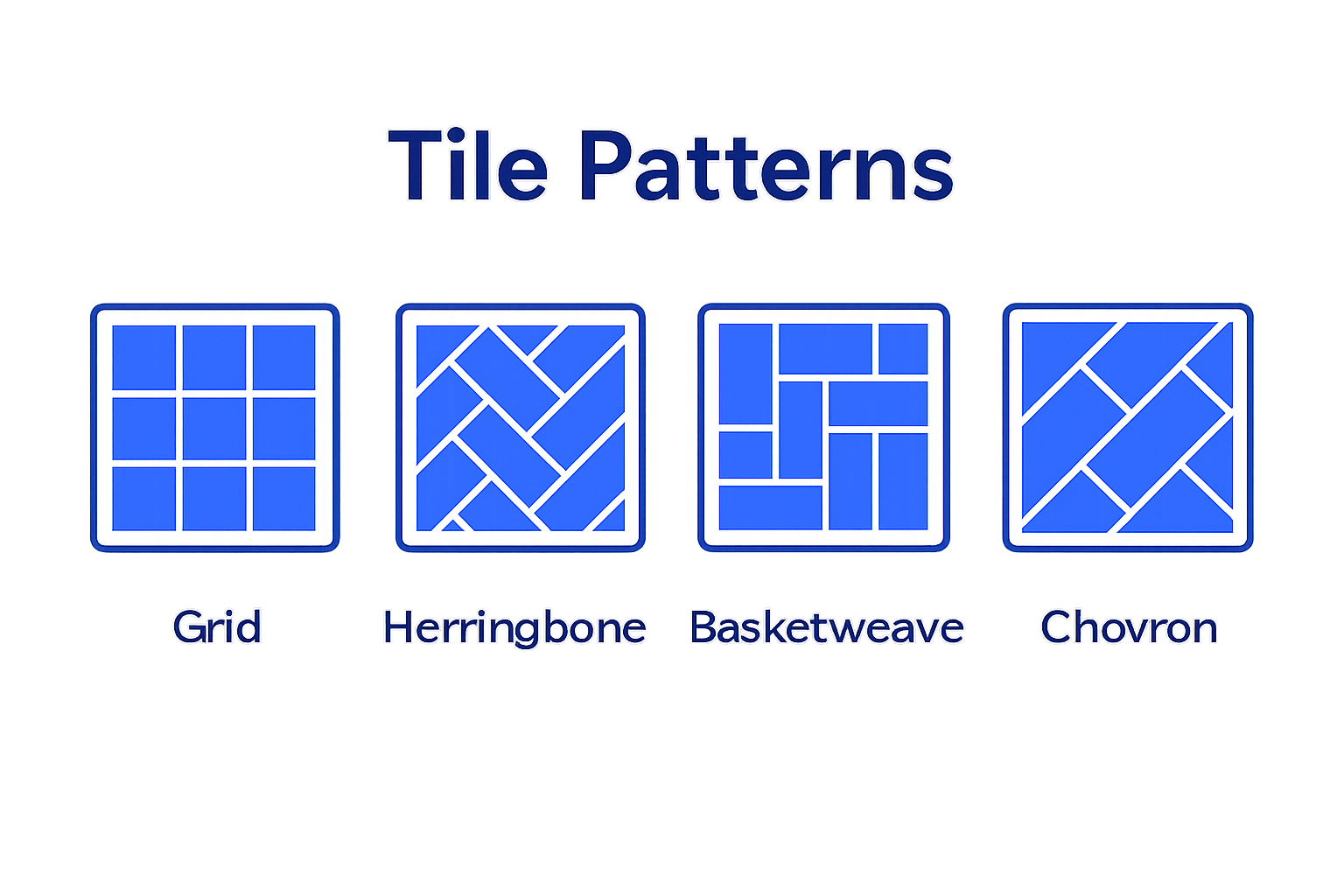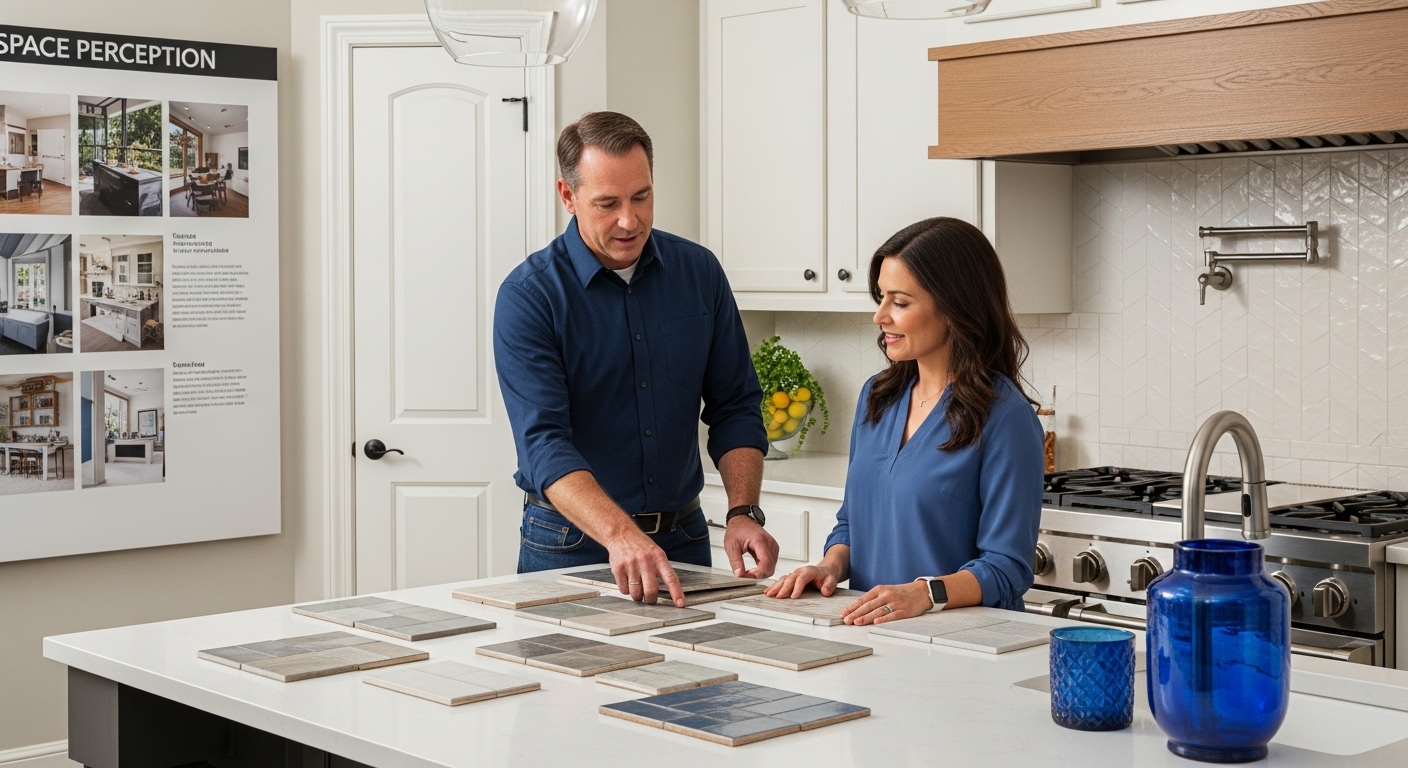Understanding the Role of Tile Patterns in Design
Posted by Mike Belk on Oct 01, 2025

Tile patterns are much more than decoration. They can completely change how a room feels and even trick the eye into seeing more space or depth. Here is what most people miss. Research shows that simply changing the pattern of tiles can influence your mood, expand perceived room size, and create movement that catches the attention. This is not guesswork. It is a deliberate design strategy that turns basic surfaces into eye-catching statements.
Table of Contents
- What Are Tile Patterns And Their Types?
- Why Tile Patterns Matter In Interior Design
- How Tile Patterns Influence Space Perception
- Key Concepts Behind Tile Pattern Design
- Practical Applications Of Tile Patterns In Various Settings
Quick Summary
| Takeaway | Explanation |
|---|---|
| Tile patterns impact space perception. | Strategic arrangements can alter how dimensions are viewed within a space, making areas feel larger or more dynamic. |
| Common patterns include grid and herringbone. | Understanding various tile patterns helps in choosing designs that fit specific aesthetic and functional needs. |
| Patterns influence emotional responses. | Different configurations can evoke emotions, such as calmness through simplicity or engagement through complexity. |
| Tile patterns function in residential and commercial spaces. | They serve practical purposes like defining zones and guiding movement while enhancing visual appeal. |
| Geometric principles underlie pattern designs. | Successful designs use mathematics to create visually appealing arrangements that balance form and function. |
What are Tile Patterns and Their Types?
Tile patterns represent strategic arrangements of tiles that transform ordinary surfaces into visually compelling design elements. These carefully orchestrated layouts go beyond mere functional coverings, serving as powerful visual tools that can dramatically alter a space’s aesthetic and perceived dimensions. Learn more about how tile patterns define your space.
Understanding Tile Pattern Fundamentals
At their core, tile patterns are systematic arrangements of individual tiles that create visual rhythms, textures, and spatial illusions. These configurations are not random but meticulously planned design strategies that leverage geometry, color, and spatial relationships. Tile patterns can make rooms appear larger, create focal points, or establish specific design moods through strategic placement and selection.
Key characteristics of effective tile patterns include:
- Visual continuity and flow
- Balanced geometric relationships
- Harmonious color and texture interactions
- Ability to manipulate perceived space dimensions
Common Tile Pattern Categories
Tile patterns are typically classified into several fundamental categories that designers and homeowners utilize to achieve specific aesthetic goals. Research from the Design Institute of America suggests these primary pattern types include:
-
Grid/Straight Lay Pattern: The most straightforward arrangement where tiles are placed in uniform horizontal and vertical lines, creating a clean and orderly appearance.
-
Herringbone Pattern: A dynamic diagonal arrangement where rectangular tiles are placed at 45-degree angles, creating a sense of movement and visual intrigue.
-
Basketweave Pattern: An intricate design mimicking woven fabric, alternating tiles to create a complex interlocking visual effect.
-
Chevron Pattern: Similar to herringbone but with precisely cut tiles meeting at perfect point, producing a sharp, directional visual flow.
Each pattern carries unique visual implications, transforming ordinary surfaces into compelling design statements that reflect architectural style, spatial dynamics, and personal aesthetic preferences.
Below is a comparative table outlining the defining features, visual benefits, and typical uses of the four most common tile patterns discussed in the article.
| Tile Pattern | Defining Feature | Visual Benefit | Typical Use |
|---|---|---|---|
| Grid/Straight Lay | Uniform horizontal and vertical arrangement | Clean, orderly appearance | Contemporary kitchens, baths |
| Herringbone | Rectangular tiles at 45-degree angles | Dynamic movement, visual intrigue | Entryways, accent walls |
| Basketweave | Alternating tiles mimic woven fabric | Complex, interlocking visual texture | Historic remodels, feature areas |
| Chevron | Precisely cut tiles meet at sharp points | Sharp, directional visual flow | Modern spaces, artistic zones |
 The strategic selection of tile patterns allows designers and homeowners to curate environments that are both functional and visually captivating.
The strategic selection of tile patterns allows designers and homeowners to curate environments that are both functional and visually captivating.
Why Tile Patterns Matter in Interior Design
Tile patterns transcend mere decorative elements, functioning as critical design components that profoundly influence spatial perception, emotional response, and architectural character. Learn more about elevating your home’s aesthetics with tile designs.
Psychological and Visual Impact
Interior designers recognize tile patterns as powerful psychological tools that shape human perception and emotional experience within a space. These intricate arrangements do more than cover surfaces they communicate visual narratives that trigger specific psychological responses. Complex geometric patterns can stimulate mental engagement, while simpler layouts promote calmness and visual serenity.
Research from The Color and Space Psychology Institute reveals that strategic tile patterns can:
- Influence perceived room dimensions
- Create visual depth and movement
- Modulate emotional atmosphere
- Guide visual attention
Functional and Aesthetic Significance
Beyond aesthetic appeal, tile patterns serve critical functional purposes in interior design. They manage spatial dynamics, create visual transitions, and solve architectural challenges. Diagonal patterns can make narrow rooms appear wider, while intricate designs can break monotony in large, open spaces.
Key functional considerations of tile patterns include:
-
Enhancing architectural flow
-
Concealing structural imperfections
-
Managing visual weight and balance
-
Creating focal points and visual hierarchy
The strategic selection of tile patterns represents a sophisticated design language that communicates style, functionality, and spatial intelligence.
The following table summarizes key psychological and functional impacts of tile patterns as described in the article, helping to clarify their dual role in interior design.
| Impact Type | Description |
|---|---|
| Psychological | Guides mood, creates visual depth, and stimulates engagement or calmness |
| Spatial | Alters room dimensions through optical illusions |
| Functional | Defines zones, manages transitions, enhances flow, and conceals imperfections |
| Emotional | Evokes feelings such as engagement, energy, or tranquility depending on pattern choice |
How Tile Patterns Influence Space Perception
Tile patterns are sophisticated visual instruments that dramatically manipulate spatial perception, transforming how individuals experience and interpret interior environments. Explore our ultimate guide to understanding patterned tiles.
Spatial Dimension Manipulation
Tile arrangements possess an extraordinary ability to alter perceived room dimensions through strategic geometric configurations. Directional patterns can elongate or widen spaces, creating optical illusions that fundamentally reshape architectural experiences. According to environmental psychology research, certain tile layouts trigger complex neurological responses that influence spatial interpretation.
Key ways tile patterns modify spatial perception include:
-
Expanding perceived room width through diagonal arrangements
-
Creating depth through layered geometric designs
-
Generating visual movement across surfaces
-
Redirecting visual focus through strategic placement
Psychological Perception and Visual Dynamics
Beyond physical dimensions, tile patterns interact with human cognitive processes, subtly guiding attention and emotional responses. Complex patterns stimulate mental engagement, while uniform layouts promote visual calmness. Different pattern configurations communicate distinct psychological narratives about space, influencing how occupants emotionally and intellectually interact with their environment.
The interaction between tile patterns and human perception involves sophisticated visual principles:
-
Neurological responses to geometric repetition
-
Subconscious interpretation of spatial rhythms
-
Emotional resonance with design complexity
-
Unconscious navigation cues embedded in tile arrangements
Tile patterns represent more than decorative elements they are nuanced design languages that communicate spatial intelligence, transforming ordinary surfaces into dynamic, perceptually rich experiences that subtly guide human interaction and emotional response.

Key Concepts Behind Tile Pattern Design
Tile pattern design represents a sophisticated intersection of mathematical precision, artistic creativity, and spatial intelligence. Discover seven popular tile patterns to enhance your home decor and understand the nuanced principles that guide their creation.
Mathematical Foundations of Pattern Development
Geometric principles form the fundamental framework for tile pattern design, where mathematical symmetry, repetition, and proportion become critical design elements. Designers leverage mathematical concepts like tessellation, scaling, and geometric transformations to create visually compelling arrangements that transcend simple surface coverage.
Key mathematical considerations in tile pattern design include:
-
Symmetrical and asymmetrical geometric configurations
-
Proportional relationships between tile dimensions
-
Modular design principles that enable complex arrangements
-
Algorithmic approaches to pattern generation
Design Theory and Aesthetic Principles
Tile pattern design integrates complex aesthetic theories that go beyond pure visual appeal. According to architectural design research, successful tile patterns balance multiple design considerations:
-
Visual rhythm and repetition
-
Cultural and contextual relevance
-
Material properties and interaction
-
Emotional and psychological impact
Designers must simultaneously consider technical constraints, material properties, spatial dynamics, and aesthetic objectives. The most compelling tile patterns emerge from a delicate balance between mathematical precision, artistic vision, and functional requirements. They communicate sophisticated design languages that transform surfaces from mere functional coverings into dynamic, expressive architectural elements that engage viewers and shape spatial experiences.
Practical Applications of Tile Patterns in Various Settings
Tile patterns transcend aesthetic considerations, serving critical functional roles across diverse architectural environments. Explore innovative tile design solutions for different spaces.
Residential Space Transformations
Residential environments represent primary landscapes where tile patterns dramatically influence spatial perception and emotional atmosphere. Different rooms demand unique pattern strategies that enhance both visual appeal and functional requirements. Kitchens and bathrooms particularly benefit from strategic tile pattern selections that manage visual complexity, moisture resistance, and design cohesion.
Key residential tile pattern applications include:
-
Creating visual depth in compact spaces
-
Defining functional zones within open floor plans
-
Enhancing natural light reflection
-
Managing visual transitions between different areas
Commercial and Public Space Design
In commercial settings, tile patterns become sophisticated design tools that communicate brand identity, manage traffic flow, and create memorable spatial experiences. According to architectural design research, strategic tile patterns can:
-
Guide visitor movement through visual cues
-
Create psychological zones within large spaces
-
Communicate institutional or corporate aesthetics
-
Manage acoustic and visual complexity
Designers leverage tile patterns as nuanced communication platforms, transforming surfaces from mere architectural elements into dynamic storytelling mediums. By integrating mathematical precision with creative vision, tile patterns emerge as powerful design instruments that shape human experience across residential, commercial, and public architectural environments.
Redefine Your Space with Patterned Tile Solutions
Are you struggling to make your space feel larger, more welcoming, or visually inspiring? From the article “Understanding the Role of Tile Patterns in Design,” you have learned how tile patterns shape the look and feel of every room. With so many choices like herringbone, chevron, grid, and basketweave, selecting the right pattern and product can be overwhelming. You want surfaces that are not only beautiful but also transform the way you and your guests experience a room.
Let BELK Tile help you turn design insights into reality. Our extensive selection of high-quality tiles lets you bring any pattern from your imagination to life, supporting spaces that express your unique style and maximize every inch. Start exploring our unmatched tile options on the BELK Tile home page. If you are looking for more ways to leverage patterned tiles in your project, be sure to check out our ultimate guide to patterned tiles and our tips on how tile patterns define your space. Shop now to create a space that truly stands out and let your next project set a new standard for design.
Frequently Asked Questions
What are tile patterns?
Tile patterns are systematic arrangements of tiles that create visual rhythms, textures, and spatial illusions, enhancing the aesthetic appeal of surfaces.
How do tile patterns affect space perception?
Tile patterns can manipulate perceived room dimensions by creating optical illusions, such as making rooms appear larger or directing visual focus through strategic placements.
What are the common types of tile patterns?
Common tile patterns include grid/straight lay, herringbone, basketweave, and chevron, each offering unique visual characteristics and design implications.
Why are tile patterns important in interior design?
Tile patterns play a crucial role in interior design by enhancing visual appeal, managing spatial dynamics, and influencing emotional responses within a space.



